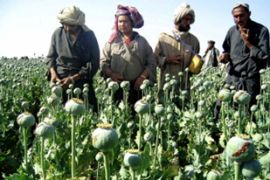UN fears surge in drug production
Colombian and Afghan instability ‘contributes’ to rise in opium and coca cultivation.

However, the report noted that the global drug problem “was dramatically reduced over the past century and has stabilised over the past 10 years”.
Combating instability
The report also noted that 80 per cent of drugs output in Afghanistan came from provinces where Taliban fighters were based.
“Greater stability and higher economic assistance are getting rid of opium in many provinces of Afghanistan … [but] counter-narcotics and counter-insurgency must be fought together,” Antonio Maria Costa, head of the UNDOC said.
Opium cultivation also rose in southeast Asia after six years of decline, mainly due to a 29 per cent surge in Myanmar, formerly known as Burma, the report said.
However, the opium poppy grown in Afghanistan has a higher yield than that of Myanmar and as a result global opium production has doubled since 1998.
The report also said that Afghanistan had become a major cannabis producer, possibly overtaking the current top producer, Morocco.
Meanwhile, in Colombia the report said the rise in cultivation occurred mainly in areas held by the Revolutionary Armed Forces of Colombia (Farc) rebel group.
Costa said the Colombian government had launched a successful campaign against armed groups and drug traffickers in the past few years, mainly through aerial eradication of large-scale coca plots with crop spraying.
“In Colombia, just like in Afghanistan, the regions where most coca is grown are under the control of insurgents”, he said.
“In the future, with the Farc in disarray, it may become easier to control coca cultivation.”